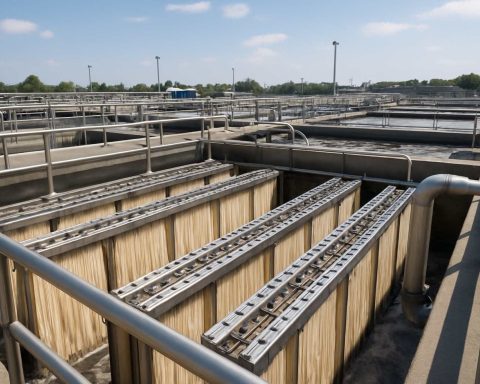In 2025, the nuclear sector is experiencing a transformative shift, with pivotal advancements reshaping its future. From the United States paving the way for small modular reactors (SMRs) to Saudi Arabia’s ambitions in uranium development, the landscape is evolving rapidly.
Tennessee Valley Authority Takes the Lead
The Tennessee Valley Authority (TVA) is spearheading an ambitious initiative, bidding $800 million from the U.S. Department of Energy to enhance SMR deployment. Partnering with industry giants like Bechtel and Duke Energy, TVA aims for swift construction of its Clinch River site in Tennessee. This project promises to create jobs and support a sustainable energy future, with the potential for commercial operations starting as early as 2033.
Mixed Signals from China
Chinese nuclear giants, China General Nuclear (CGN) and China National Nuclear Corporation (CNNC), are delivering mixed results in power generation. While CGN reported a 6% increase in output, CNNC faced a slight decline due to maintenance, highlighting the complex dynamics within China’s ambitious nuclear expansion.
Saudi Arabia Looks to Uranium
On the international stage, the Saudi Energy Minister has announced plans to explore uranium enrichment, which could significantly diversify the country’s energy portfolio. This initiative is at the forefront of Saudi Arabia’s goal to incorporate nuclear power into its energy mix, amidst discussions of regional security and energy independence.
With ongoing collaborations and innovations, the nuclear industry is indeed witnessing a pivotal moment as it aligns with global energy demands and sustainability goals.
A New Dawn for Nuclear Energy
The evolution of the nuclear sector extends beyond mere technological advancements; it carries profound implications for societal energy dynamics, cultural attitudes towards nuclear power, and the global economy. As countries pivot toward energy diversification, the deployment of technologies such as small modular reactors (SMRs) reveals a clear trend: a collective ambition for energy independence and sustainability. The success of initiatives like the Tennessee Valley Authority’s project will not only rejuvenate local economies through job creation but also bolster the confidence of public opinion, which has been historically polarized regarding nuclear energy.
Moreover, the geopolitical landscape is shifting. Saudi Arabia’s pursuit of uranium enrichment signifies a transformative moment in Middle Eastern energy strategy. This pursuit is more than a technical endeavor; it signals a push for regional autonomy in energy production, potentially recalibrating power dynamics in an already fragile political environment. The desire for self-sufficiency cannot be understated, especially as nations seek alternatives to fossil fuel dependence.
However, the nuclear renaissance does not come without environmental considerations. The future of nuclear energy will hinge on addressing concerns like waste management and the environmental footprint of uranium mining. As the industry navigates these challenges, future trends will likely lean towards sustainably sourced materials and cutting-edge waste recycling technologies.
In sum, the ongoing innovations in the nuclear sector are poised to reshape not only energy consumption patterns but also economic and environmental frameworks on a global scale. The long-term significance will be felt far beyond energy policies, influencing cultural acceptance and the pursuit of a sustainable future.
The Future of Nuclear Energy in 2025: Innovations and Global Dynamics
The nuclear sector in 2025 is experiencing a significant transformation driven by technological advancements and strategic global initiatives. As countries invest in sustainable energy solutions, the landscape of nuclear energy continues to evolve rapidly, with notable developments in the United States, China, and Saudi Arabia.
The Rise of Small Modular Reactors (SMRs)
Tennessee Valley Authority’s Bold Move
The Tennessee Valley Authority (TVA) is at the forefront of this transformation, actively pursuing a substantial $800 million bid from the U.S. Department of Energy to accelerate the deployment of Small Modular Reactors (SMRs). This initiative, in collaboration with industry leaders such as Bechtel and Duke Energy, focuses on constructing the Clinch River site in Tennessee. The TVA aims for commercial operations by 2033, which could lead to the creation of numerous job opportunities while fortifying a more sustainable energy future.
Pros and Cons of SMRs
– Pros:
– Reduced construction times compared to traditional reactors.
– Enhanced safety features due to their smaller size.
– Scalability to meet varying energy demands.
– Cons:
– High initial investment costs.
– Regulatory hurdles and public perception challenges.
The success of SMRs may play a crucial role in revitalizing the nuclear industry, especially as energy needs grow globally.
China’s Nuclear Ambitions
Mixed Performance Among Major Players
China’s nuclear ambitions continue to unfold, albeit with mixed outcomes. Major corporations such as China General Nuclear (CGN) reported a 6% increase in power generation, showcasing a positive trajectory. However, the China National Nuclear Corporation (CNNC) encountered a slight downturn due to maintenance issues. This scenario illuminates the complexities and challenges faced by China’s nuclear sector as it strives for expansion amidst operational hurdles.
Saudi Arabia’s Uranium Development
A Shift Towards Nuclear Power
On the international front, Saudi Arabia is taking significant steps towards diversifying its energy portfolio by exploring uranium enrichment. The Saudi Energy Minister’s announcement signals a pivotal shift as the nation aims to integrate nuclear power into its energy mix. This initiative comes amid broader discussions regarding regional security and energy independence, marking a critical step in Saudi Arabia’s strategy to harness nuclear energy for sustainable development.
Use Cases for Nuclear Energy in Saudi Arabia
– Energy diversification: Reducing dependence on oil and gas.
– Economic growth: Creating jobs in emerging nuclear sectors.
– Regional stability: Enhancing energy security through diversified sources.
Innovations and Trends in Nuclear Energy
As the nuclear sector progresses, innovations play a vital role in shaping its future. Emerging technologies focus on improving reactor efficiency, safety protocols, and waste management systems. There is a clear trend toward adopting more sustainable practices, including exploring advanced reactor designs and innovations like fusion energy, which could redefine the energy landscape in the coming decades.
Security Aspects and Sustainability
In light of global concerns about energy security and climate change, the nuclear industry is increasingly prioritizing sustainability. Advanced reactors are being designed not only for efficiency but also with enhanced safety measures to mitigate risks associated with nuclear energy. Furthermore, the integration of renewable energy sources with nuclear infrastructure could provide a comprehensive approach to meet future energy demands sustainably.
Conclusion
As we progress through 2025, the nuclear energy sector stands at a crossroads, filled with opportunities and challenges. The advancements in SMR technology in the U.S., China’s evolving dynamics in nuclear production, and Saudi Arabia’s strategic uranium ambitions all illustrate the transformative changes occurring. This collaborative and innovative spirit is essential as the world seeks reliable and sustainable energy solutions.
For more insights and updates on global energy trends, visit Energy.gov.








